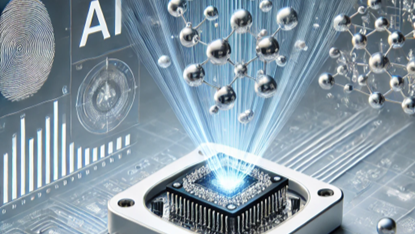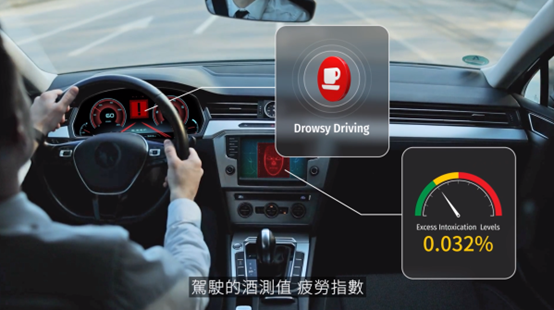
AI olfactory sensing enabled by silicon photonics technology. Picture/N&M offered
The rapid rise of artificial intelligence (AI) is driving global economic growth. However, AI's effectiveness relies heavily on big data and advanced algorithms. A critical portion of this data originates from various sensing technologies, forming the backbone of AIoT (AI + IoT). While AI today largely depends on vision-based sensors, it lacks advanced capabilities in olfactory and gustatory senses—two key components of human perception.
Silicon photonics sensing technology is poised to transform AI by enabling olfactory capabilities. Traditional AI sensory systems have primarily focused on vision, hearing, and touch. However, the complexities of chemical reactions and diverse molecular compositions have made smell and taste challenging domains. The advent of silicon photonics offers a breakthrough, surpassing traditional methods like electrochemical and compound semiconductor technologies in integration and versatility.
Silicon photonics integrates optical components onto semiconductor platforms, leveraging principles like interference and non-dispersive infrared (NDIR) absorption. This enables precise identification and real-time analysis of complex molecular structures, allowing AI to recognize and learn odors. Applications extend to health diagnostics, food safety, and environmental monitoring. As silicon photonics advances, its precision and speed in detecting smells will enhance AI's sensory ecosystem, creating richer human-machine interactions.
Market Trends and Applications of Sensors
According to IDTechEx, the global sensor market, driven by AI, 6G, and IoT, is projected to reach $253 billion by 2035. Sensors, essential for converting physical signals into data, are used across communications, transportation, healthcare, industrial, and energy sectors. Established technologies like compound semiconductors, optical sensors, and electrochemical sensors dominate the market today. However, emerging solutions like silicon photonics are gaining traction due to their superior precision, low power consumption, and compact, multifunctional designs.
In transportation, sensors play a pivotal role in electrification, in-vehicle monitoring, and autonomous driving. For example, the development of autonomous driving and electric vehicles has driven the demand for battery monitoring, radar and LiDAR sensors, and time-of-flight ranging (ToF). As awareness of cabin air quality grows, sensors are increasingly employed to monitor pollutants like PM2.5, CO, CO₂, and VOCs. Legislative discussions around mandatory in-car alcohol detection systems further highlight the expanding scope of sensor applications.

Silicon photonics sensing enhances in-car air quality monitoring. Picture/N&M offered
Silicon photonics sensing has great potential in wearable devices, Internet of Things (IoT) and environmental monitoring applications, especially in health and industrial applications. The success of smart watches and fitness trackers, as well as the innovation of the blood glucose monitoring market, show the potential opportunities in this market; IoT applications cover markets such as logistics, industry, construction, agriculture, and medical care; in addition, the demand for air quality monitoring has also increased significantly. Silicon photonics sensing technology can provide a new integrated solution for the above applications.
Principles and Structure of Gas Detection
Gas detection commonly utilizes NDIR technology, which measures specific gas concentrations based on their infrared absorption characteristics. A typical NDIR sensor includes an infrared source, gas sample chamber, optical filter, and detector. Target gases absorb specific wavelengths of infrared light, and the residual light reaching the detector is used to calculate gas concentration. This method is highly sensitive, stable, and durable, making it suitable for environmental monitoring, industrial safety, and medical applications.
Silicon Photonics: Mechanisms and Advantages
Silicon photonics sensing technology leverages the optical properties of silicon to detect and measure various physical, chemical, and biological parameters. The fundamental optical principles it employs primarily include phenomena such as resonance and interference. A common structure in silicon photonics sensors is the grating, which selectively reflects specific wavelengths of light based on its design. This wavelength selectivity enables the detection of particular characteristics of a target object. For instance, changes in temperature or strain can alter the output wavelength, allowing precise measurement through this shift.
Interference is one of the most widely used optical phenomena in silicon photonics sensing. When two light waves overlap, they produce an interference pattern of alternating bright and dark fringes, which are highly sensitive to optical path differences (phase shifts). This sensitivity enables the detection of minute displacements, strains, or other physical quantities.
Another prevalent structure in silicon photonics sensing is the optical ring resonator, also known as a micro-ring resonator (MRR). When light of a specific wavelength enters the resonator, it can undergo constructive interference under certain conditions, resulting in resonance. The resonant light can then be directed through another waveguide, functioning as a spectral filter. This extreme sensitivity to specific wavelengths makes it possible to detect changes in parameters such as temperature, pressure, or chemical concentration, which cause shifts in the resonant wavelength.
In essence, silicon photonics sensing integrates various optical principles and phenomena, such as non-dispersive infrared (NDIR) absorption, waveguides, gratings, interference, and resonance, to achieve high-precision detection across diverse parameters. Its advantages include high sensitivity, miniaturization, low cost, and compatibility with existing semiconductor manufacturing processes. These strengths position silicon photonics sensing as a highly versatile technology with broad potential applications.
Conclusion
Silicon photonics sensing technology marks a significant breakthrough in equipping AI with olfactory capabilities. Its precise molecular detection not only captures subtle odor changes but also enables real-time data processing, granting AI human-like scent recognition. The technology's progression in the AIoT domain promises a comprehensive upgrade to AI's sensory framework, from medical diagnostics to environmental monitoring.
As silicon photonics reshapes the sensor market, its innovations will set new benchmarks for accuracy, efficiency, and integration. This transformative technology opens up untapped markets, driving advancements in autonomous vehicles, wearable devices, and IoT ecosystems while enriching human-machine interactions.